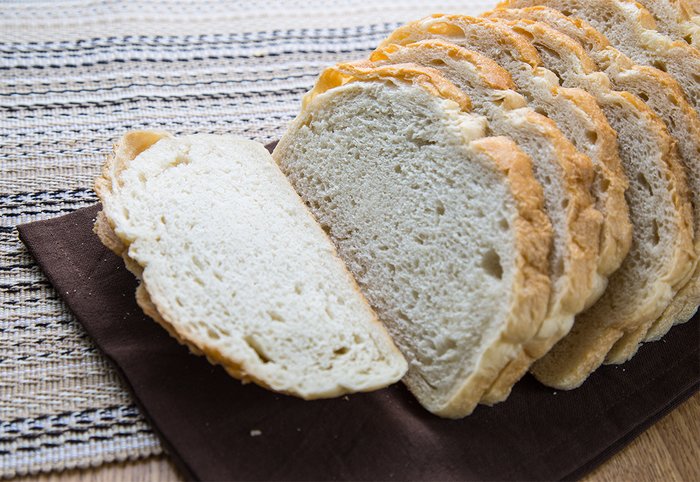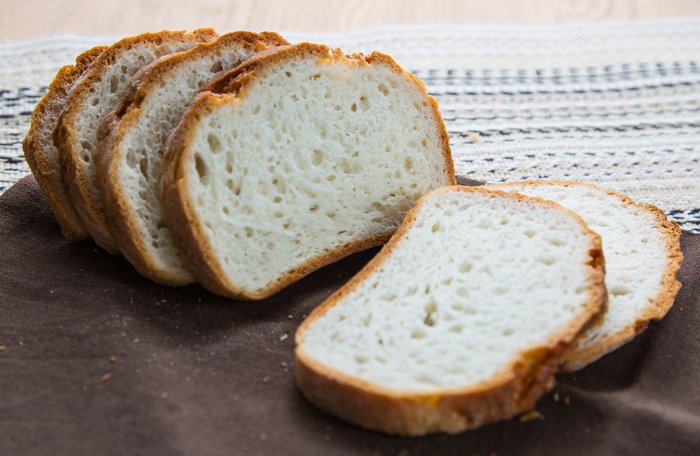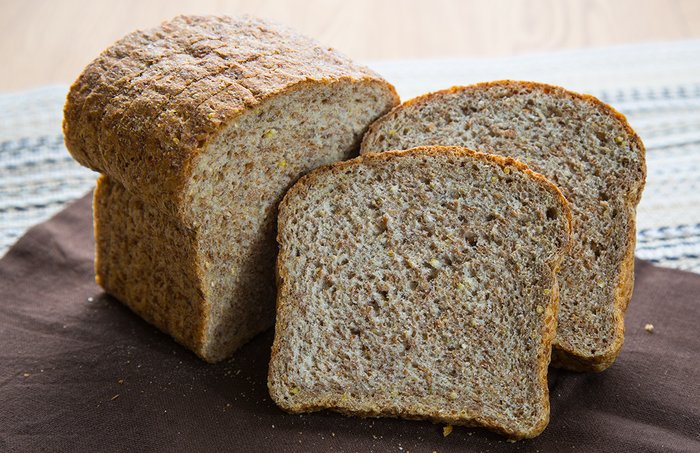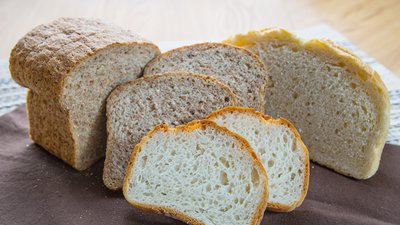Despite all the bread haters out there, this 30,000-year-old food remains a daily dietary staple for millions of people. Without question, bread can serve as a convenient way to obtain the carbohydrates you need to power your workouts. And if you choose your loaf carefully, it can also infuse your diet with a range of vital nutrients your active body craves.
The key is to choose the healthiest kinds that won't end up stuck to your waistline. Any way you slice it, the following breads can become your preferred platform for everything from sandwiches to avocado toast.
Sprouted-Grain Bread
Most breads are baked from wheat grains that have been ground into flour. Sprouted-grain breads are made from whole grains such as oats, whole wheat, and barley that have been allowed to germinate, or sprout, into the early stages of a new plant before they are ground up. This approach makes bread a whole lot healthier, and often tastier.
The process of sprouting grains not only gives bread a nuttier flavor, it also appears to minimize the presence of phytic acid.[1] Consuming bread that contains less phytic acid makes it easier for your body to absorb nutrients like zinc and magnesium found in the grain. In fact, research has found that the sprouting process may increase levels of fiber, folate, and key antioxidants available in the grain.[2-8] Eating sprouted-grain bread can also result in a lower rise in blood sugar compared to other breads, such as 11-grain bread and white bread.[9]

Germination of the grains also appears to reduce the presence of oligosaccharides, a group of carbohydrates that can be hard to digest, leading to gas and bloating.[10] Sprouted-grain breads also tend to have less sugar and more protein than their non-sprouted counterparts.
Many sprouted breads are made without preservatives and tend to spoil faster than regular bread, so look for them in the freezer or refrigerator sections of grocery stores. Look for breads made with a majority of sprouted grains. They'll all include whole grains, since you can't sprout refined grains. Some sprouted breads also contain healthy additions like legumes, sunflower seeds, and flax.
Sourdough
Making a loaf of sourdough bread involves the ancient baking tradition of using a bacteria-rich starter to ferment the dough. Fermentation gives this bread its notable tang and some important health perks.
In comparison to bread leavened using baker's yeast, sourdough bread can result in a lower post-meal blood glucose response. Canadian researchers found that consuming 50 grams of carbohydrates from white sourdough bread resulted in less of a post-meal blood glucose surge than non-sourdough whole wheat bread.[11] This lower surge appears to be caused by the bacterial fermentation process, which also slows digestion and decreases the amount of gluten present in the final product, making sourdough potentially easier for some people to digest.[12, 13]

While much of the sourdough on the market is made with white flour, whole grain sourdough, such as dense rye, can be even healthier. Watch out for wannabes labeled as "sour breads" that use flavoring agents like vinegar to make it sour. These won't have the metabolic benefits of bacterial-driven sourdough.
Gluten Free
It wasn't too long ago that gluten-free bread was a very laboriously acquired taste with its sandpaper-like texture, cardboard-like taste, and luxury item-like price tag. Most gluten-free breads back then were usually made with heavily refined carbs, like rice flour and potato starch.
But as gluten-free eating has become mainstream, more brands are working harder to make breads that actually taste good and provide a healthy complement of nutrients. Instead of processing traditional grains to remove gluten, brands now use nutritious, gluten-free whole grains, including brown rice flour, buckwheat, teff, quinoa, millet, amaranth, and sorghum.

Teff, a grain from Ethiopia, is richer in iron than wheat, while quinoa, originally from the Andes, provides higher-quality protein. Gluten-free brands are experimenting with other healthy add-ins like chia seeds, flax, and inulin for a shot of extra fiber. You can also go gluten free by using "no-grain" breads made with almond flour that provide lots of protein and healthy unsaturated fats.
Look for gluten-free bread products like sandwich slices, pitas, and bagels with an ingredient list that places a whole grain as the first carb, and contains no more than 2 grams of sugar per slice.
References
- Cornejo, F., Caceres, P. J., Martínez-Villaluenga, C., Rosell, C. M., & Frias, J. (2015). Effects of germination on the nutritive value and bioactive compounds of brown rice breads. Food Chemistry, 173, 298-304.
- Perales-Sánchez, J. X., Reyes-Moreno, C., Gómez-Favela, M. A., Milán-Carrillo, J., Cuevas-Rodríguez, E. O., Valdez-Ortiz, A., & Gutiérrez-Dorado, R. (2014). Increasing the antioxidant activity, total phenolic and flavonoid contents by optimizing the germination conditions of amaranth seeds. Plant Foods for Human Nutrition, 69(3), 196-202.
- Cáceres, P. J., Martínez-Villaluenga, C., Amigo, L., & Frias, J. (2014). Assessment on proximate composition, dietary fiber, phytic acid and protein hydrolysis of germinated Ecuatorian brown rice. Plant Foods for Human Nutrition, 69(3), 261-267.
- Platel, K., Eipeson, S. W., & Srinivasan, K. (2010). Bioaccessible mineral content of malted finger millet (Eleusine coracana), wheat (Triticum aestivum), and barley (Hordeum vulgare). Journal of Agricultural and Food Chemistry, 58(13), 8100-8103.
- Pradeep, P. M., & Sreerama, Y. N. (2015). Impact of processing on the phenolic profiles of small millets: Evaluation of their antioxidant and enzyme inhibitory properties associated with hyperglycemia. Food Chemistry, 169, 455-463.
- Esa, N. M., Kadir, K. K. A., Amom, Z., & Azlan, A. (2013). Antioxidant activity of white rice, brown rice and germinated brown rice (in vivo and in vitro) and the effects on lipid peroxidation and liver enzymes in hyperlipidaemic rabbits. Food Chemistry, 141(2), 1306-1312.
- Hefni, M., & M. Witthöft, C. (2012). Enhancement of the folate content in Egyptian pita bread. Food & Nutrition Research, 56(1), 5566.
- Hung, P. V., Maeda, T., Yamamoto, S., & Morita, N. (2012). Effects of germination on nutritional composition of waxy wheat. Journal of the Science of Food and Agriculture, 92(3), 667-672.
- Mofidi, A., Ferraro, Z. M., Stewart, K. A., Tulk, H. M., Robinson, L. E., Duncan, A. M., & Graham, T. E. (2012). The acute impact of ingestion of sourdough and whole-grain breads on blood glucose, insulin, and incretins in overweight and obese men. Journal of Nutrition and Metabolism, 2012.
- Sampath, S., Rao, M. T., Reddy, K. K., Arun, K., & Reddy, P. V. M. (2008). Effect of germination on oligosaccharides in cereals and pulses. Journal of Food Science and Technology-Mysore, 45(2), 196-198.
- Najjar, A. M., Parsons, P. M., Duncan, A. M., Robinson, L. E., Yada, R. Y., & Graham, T. E. (2008). The acute impact of ingestion of breads of varying composition on blood glucose, insulin and incretins following first and second meals. British Journal of Nutrition, 101(3), 391-398.
- Rizzello, C. G., Montemurro, M., & Gobbetti, M. (2016). Characterization of the Bread Made with Durum Wheat Semolina Rendered Gluten Free by Sourdough Biotechnology in Comparison with Commercial Gluten‐Free Products. Journal of Food Science, 81(9).
- Rizzello, C. G., De Angelis, M., Di Cagno, R., Camarca, A., Silano, M., Losito, I., ... & Gianfrani, C. (2007). Highly efficient gluten degradation by lactobacilli and fungal proteases during food processing: new perspectives for celiac disease. Applied and Environmental Microbiology, 73(14), 4499-4507.

